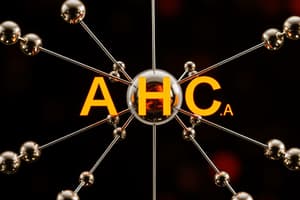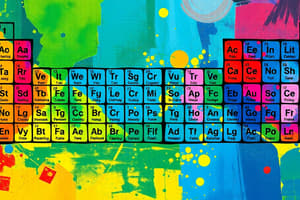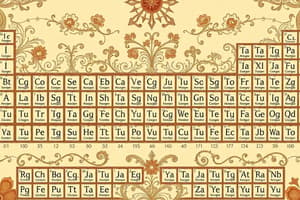Podcast
Questions and Answers
Which subatomic particle primarily determines an atom's identity and its position on the periodic table?
Which subatomic particle primarily determines an atom's identity and its position on the periodic table?
- Proton (correct)
- Isotope
- Electron
- Neutron
Metalloids exhibit exclusively metallic properties under all conditions.
Metalloids exhibit exclusively metallic properties under all conditions.
False (B)
What electronic configuration makes noble gasses relatively unreactive?
What electronic configuration makes noble gasses relatively unreactive?
A full outer electron shell
In ionic bonding, metals ______ electrons to form positive ions, while non-metals ______ electrons to form negative ions.
In ionic bonding, metals ______ electrons to form positive ions, while non-metals ______ electrons to form negative ions.
Match the following chemical families with their properties:
Match the following chemical families with their properties:
Which of the following ions does not have a charge that can be directly inferred from its group number on the periodic table?
Which of the following ions does not have a charge that can be directly inferred from its group number on the periodic table?
Diatomic molecules are formed exclusively by covalent bonding.
Diatomic molecules are formed exclusively by covalent bonding.
Describe the key features of metallic bonding that explain the high electrical conductivity of metals.
Describe the key features of metallic bonding that explain the high electrical conductivity of metals.
The formula of the ionic compound formed between aluminum (Al) and oxygen (O) is ______.
The formula of the ionic compound formed between aluminum (Al) and oxygen (O) is ______.
Which of the following best describes the type of bonding present in carbon dioxide ($CO_2$)?
Which of the following best describes the type of bonding present in carbon dioxide ($CO_2$)?
Flashcards
Protons
Protons
Positively charged particles located in the nucleus of an atom; have a mass of approximately 1 amu.
Neutrons
Neutrons
Neutral particles located in the nucleus of an atom; have a mass of approximately 1 amu.
Electrons
Electrons
Negatively charged particles orbiting the nucleus of an atom; have negligible mass.
Monatomic
Monatomic
Signup and view all the flashcards
Diatomic
Diatomic
Signup and view all the flashcards
Atomic Number
Atomic Number
Signup and view all the flashcards
Mass Number
Mass Number
Signup and view all the flashcards
Ion
Ion
Signup and view all the flashcards
Polyatomic Ion
Polyatomic Ion
Signup and view all the flashcards
Ionic Bonding
Ionic Bonding
Signup and view all the flashcards
Study Notes
- Protons, neutrons, and electrons are the fundamental particles within an atom.
- Protons are positively charged, neutrons are neutral, and electrons are negatively charged.
- Protons and neutrons reside in the nucleus, while electrons exist in shells surrounding the nucleus.
- Each element has a specific number of protons, which determines its atomic number.
- Electrons fill shells starting from the innermost, with each shell holding a limited number of electrons.
- The first shell holds up to 2 electrons, and the second and third shells typically hold up to 8 electrons each.
- Electronic configuration describes the arrangement of electrons in the shells of an atom. The electronic configurations of the first 20 elements should be known
Metals vs. Non-metals vs. Metalloids
- Metals, non-metals, and metalloids can be differentiated based on their physical properties such as conductivity, luster, and malleability.
- Metals are generally good conductors of electricity and heat, have a lustrous appearance, and are malleable and ductile.
- Non-metals are typically poor conductors of electricity and heat, lack luster, and are brittle.
- Metalloids (or semi-metals) have properties intermediate between metals and non-metals, and some are semiconductors
The Periodic Table
- The periodic table organizes elements based on their atomic number and recurring chemical properties.
- Metals are located on the left side of the periodic table, non-metals on the right side, and metalloids are between them.
- Elements can exist as solids, liquids, or gases under normal conditions.
- Chemical families, such as alkali metals (Group I), alkaline earth metals (Group II), halogens (Group VII), and noble gases (Group VIII), share similar properties. Use Roman numerals to indicate group numbers and normal numbers to indicate period numbers on the periodic table.
Definitions
- Monatomic: Consisting of one atom.
- Diatomic: Consisting of two atoms.
- Atomic number: The number of protons in the nucleus of an atom.
- Mass number: The total number of protons and neutrons in the nucleus of an atom.
- Ion: An atom or molecule with an electrical charge due to the loss or gain of electrons.
- Polyatomic ion: An ion consisting of multiple atoms bonded together.
- Ionic bonding: A type of chemical bonding involving the electrostatic attraction between oppositely charged ions.
- Metallic bonding: A type of chemical bonding in which positively charged metal ions are surrounded by a sea of delocalized electrons.
- Covalent bonding: A type of chemical bonding in which atoms share electrons to achieve a stable electron configuration.
Electronic Configurations and the Periodic Table
- The position of an element in the periodic table can be inferred from its electronic configuration.
- For example, Calcium (Ca) with electronic configuration 2.8.8.2 is in Group II and Period 4.
- Noble gases are unreactive due to their stable electronic configuration, with a full outer shell of electrons.
- They exist as uncombined single atoms (monatomic) because they do not need to form chemical bonds to achieve stability.
- Simple ions achieve a stable electron arrangement by having 8 electrons in their outer shell (or 2 for the first shell).
- The charge of simple ions can be inferred from their electronic configurations or position in the periodic table.
- When a metal combines with a non-metal, electrons are transferred from the metal to the non-metal, forming ions and resulting in an ionic compound.
Ionic Compounds
- You should know the ions, along with any that can be deduced from their position on the Periodic table: NH4+, Cu2+, Fe2+, Pb2+, Ag+, Zn2+, CO32-, OH-,NO3- , SO42-
- The formulae of ionic compounds can be deduced from the charges of the ions involved
- The names of ionic compounds can be determined from their formulae, with the metal cation listed first, followed by the non-metal anion.
Covalent Bonding
- In covalent bonding, non-metal atoms combine by sharing electrons to achieve a stable arrangement of 8 electrons in the outer shell.
Metallic Bonding
- Metallic bonding involves the delocalization of electrons among a lattice of metal atoms, creating a "sea" of electrons that are free to move throughout the structure.
- This electron mobility accounts for the characteristic properties of metals, such as high electrical and thermal conductivity, luster, and malleability.
Covalent Bonding: Explained
- Covalent bonding involves the sharing of electrons between atoms to achieve a stable electron configuration.
- Non-metal atoms commonly form covalent bonds to complete their valence shells.
- Covalent bonds can be single, double, or triple, depending on the number of electron pairs shared between atoms.
Studying That Suits You
Use AI to generate personalized quizzes and flashcards to suit your learning preferences.




